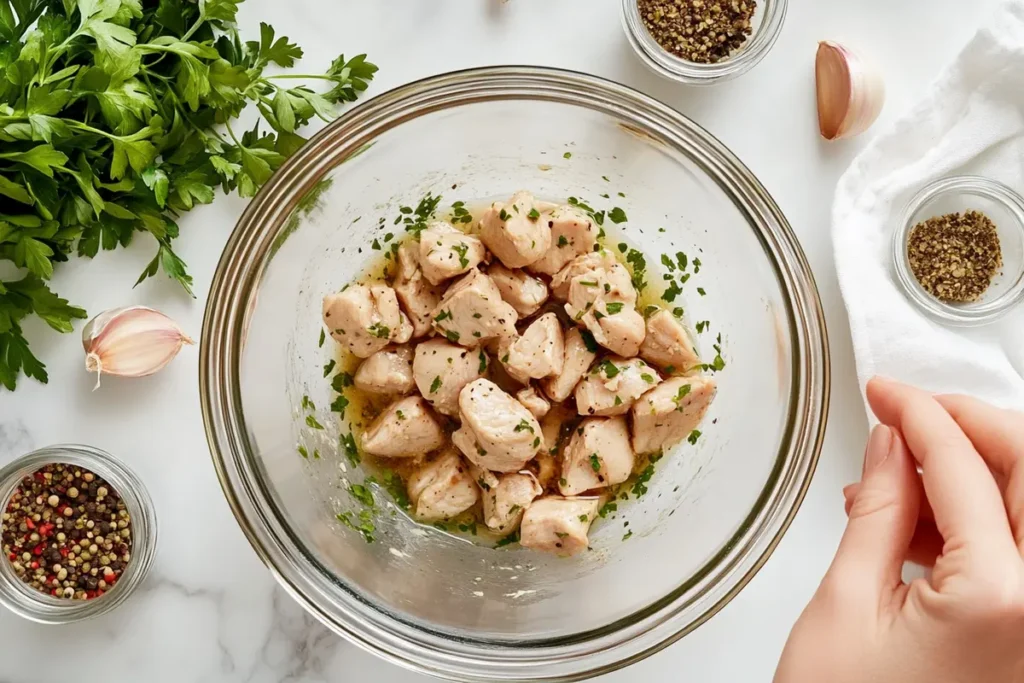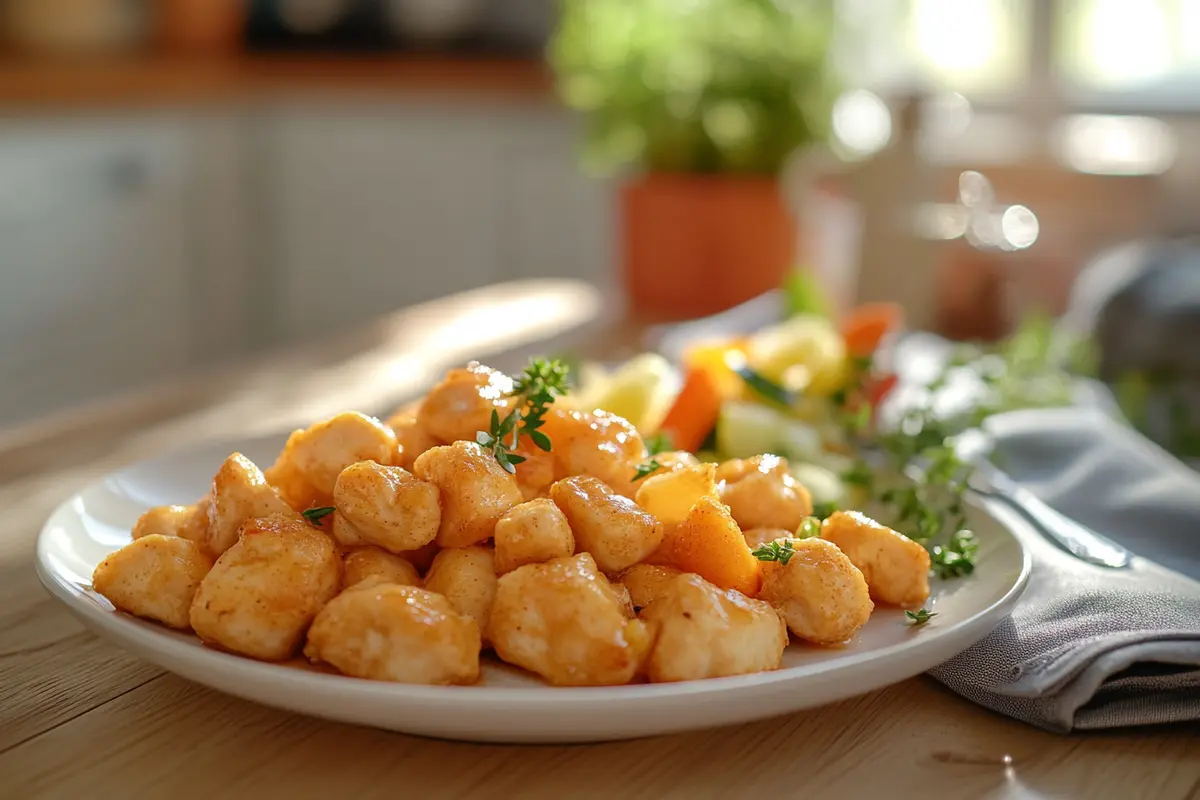Introduction to Cooking Diced Chicken
Diced chicken is one of the most versatile ingredients you’ll find in the kitchen. By cutting chicken into small, uniform pieces, you allow for even cooking and endless possibilities in recipes. But why is it so popular? For starters, diced chicken cooks quickly, absorbs marinades effortlessly, and blends beautifully with a variety of flavors. Whether you’re cooking for a crowd or preparing meals in advance, it’s the perfect option for creating delicious dishes in no time, as seen in diced chicken recipes.
Benefits of Cooking Diced Chicken
Nutritional Information for Diced Chicken (Per 100g)
| Nutrient | Amount |
|---|---|
| Calories | 165 kcal |
| Protein | 31 g |
| Total Fat | 3.6 g |
| Saturated Fat | 1 g |
| Cholesterol | 85 mg |
| Sodium | 74 mg |
| Potassium | 256 mg |
| Total Carbohydrates | 0 g |
| Dietary Fiber | 0 g |
| Sugars | 0 g |
| Iron | 0.9 mg |
| Vitamin B6 | 0.6 mg |
When you opt for diced chicken, you unlock several benefits that make your cooking both easier and more rewarding:
- Quick Cooking Time: Smaller pieces cook faster than whole cuts, saving time and energy.
- Uniform Cooking: Evenly sized pieces ensure that every bite is tender and juicy.
- Adaptable to Any Recipe: From stir-fries to soups, diced chicken fits seamlessly into any dish.
- Easier Portion Control: Pre-cut chicken allows you to measure portions more accurately.
These advantages make diced chicken a favorite among busy home cooks, as it combines speed, convenience, and versatility.
Selecting the Right Cut
When deciding on the best cut of chicken for dicing, it’s essential to consider flavor and texture. Both chicken breasts and thighs can be used, but they offer distinct differences:
- Chicken Breasts: Lean and mild in flavor, chicken breasts are perfect for lighter dishes and marinades that enhance their subtle taste.
- Chicken Thighs: Rich and succulent, thighs add depth to recipes and hold up better in slow-cooked or heavily spiced dishes.
No matter the cut, the secret lies in uniform dicing. Uneven pieces can lead to inconsistent cooking, with some pieces turning out overcooked while others remain underdone. To avoid this, use a sharp knife and aim for similar-sized cubes.
Preparation Techniques

Marination Methods
One of the most effective ways to enhance the flavor of diced chicken is through marination. A good marinade doesn’t just add taste; it also tenderizes the chicken, making it more succulent. With diced chicken, marination works quickly since the smaller pieces absorb flavors faster than whole cuts. But what’s the key to a great marinade? Balance.
A classic marinade combines acid, fat, seasoning, and aromatics:
- Acids like lemon juice, yogurt, or vinegar help tenderize the chicken by breaking down proteins.
- Fats, such as olive oil or coconut milk, lock in moisture and prevent drying out during cooking.
- Seasonings like salt, pepper, paprika, and garlic bring out the chicken’s natural flavors.
- Aromatics—think fresh herbs, ginger, or even a splash of soy sauce—add depth and complexity.
For best results, marinate diced chicken for 15–30 minutes. If you’re in a hurry, a quick rub with dry spices can still work wonders. However, avoid over-marinating, as acids can make the chicken mushy.
Quick Marinades for Busy Days
If you’re pressed for time, try these easy marinade ideas that pair well with any recipe:
- Citrus Garlic Marinade: Lemon juice, minced garlic, olive oil, and a pinch of thyme.
- Asian-Inspired Blend: Soy sauce, ginger, sesame oil, and honey for a sweet-savory kick.
- Spicy Kick Rub: Paprika, chili powder, garlic powder, and a dash of cumin.
These quick marinades ensure your diced chicken stays juicy, even if you only have a few minutes to spare.
Tenderizing the Chicken
Tenderizing is often overlooked but plays a vital role in preparing diced chicken, especially if you’re using lean cuts like chicken breast. The aim is to soften the meat while retaining its natural juices. Here are some effective tenderizing techniques:
- Physical Tenderizing: Gently pound the chicken before dicing to break down tough fibers. A rolling pin or meat mallet works well for this.
- Using Natural Tenderizers: Ingredients like yogurt, buttermilk, or pineapple juice contain enzymes that naturally tenderize the meat. Soaking diced chicken in these for about 20 minutes can make a big difference.
- Brining: A simple saltwater soak (1 tablespoon of salt per cup of water) for 15–20 minutes helps the chicken retain moisture during cooking.
Common Mistakes to Avoid
Even with the best preparation, a few missteps can ruin your chicken’s texture and flavor. Here’s what to watch out for:
- Over-marinating: Acids in the marinade can break down the chicken too much, leaving it mushy.
- Skipping the Brine: If you’re working with lean chicken breast, skipping brining can result in dryness.
- Using Cold Chicken: Always let the chicken come to room temperature before cooking to ensure even heat distribution.
Proper preparation is the foundation for perfectly cooked diced chicken. Once your chicken is marinated and tenderized, it’s ready to take on any cooking method!
Cooking Methods
Sautéing Diced Chicken on the Stovetop

Sautéing is one of the quickest and most versatile ways to cook diced chicken. This method allows you to achieve a golden crust while locking in moisture—a perfect base for stir-fries, pasta, or wraps. Here’s a step-by-step guide to get it just right, with more tips on keeping diced chicken moist while cooking:
- Preheat Your Pan: Heat a nonstick or stainless-steel skillet over medium-high heat. Add a splash of olive oil or butter.
- Season the Chicken: Pat the diced chicken dry with a paper towel to remove excess moisture. Season with salt, pepper, and your favorite spices.
- Sear the Chicken: Place the chicken pieces in the hot pan, making sure they don’t overlap. Let them cook undisturbed for 2–3 minutes to develop a golden crust.
- Flip and Finish: Turn the pieces over and cook for another 2–3 minutes or until fully cooked.
Pro Tip: Avoid overcrowding the pan; too many pieces at once can cause steaming instead of browning.
Tips for Achieving a Golden Crust
- Use medium-high heat to ensure the chicken browns evenly without drying out.
- If you want a smoky depth, add spices like smoked paprika or cumin during the cooking process.
- A light dusting of cornstarch before cooking can create a crispy exterio
Baking Diced Chicken in the Oven

For meal prep or hands-off cooking, baking is an excellent option. It’s easy, healthy, and perfect for large batches. Follow these steps for juicy baked diced chicken:
- Preheat the Oven: Set your oven to 400°F (200°C).
- Prepare a Baking Sheet: Line a baking sheet with parchment paper or lightly grease it to prevent sticking.
- Season the Chicken: Toss the diced chicken with olive oil, salt, pepper, and any desired herbs or spices. Spread the pieces out in a single layer on the sheet.
- Bake: Cook the chicken for 15–20 minutes, flipping halfway through, until the internal temperature reaches 165°F (75°C).
Pro Tip: For added flavor, drizzle a marinade over the chicken before baking or top it with shredded cheese and breadcrumbs for a casserole-style finish.
Grilling Diced Chicken
Grilling gives diced chicken a smoky, charred flavor that’s hard to resist. Whether you’re using a gas or charcoal grill, preparation is key to keeping the chicken tender and juicy:
- Prepare the Grill: Preheat your grill to medium-high heat. Oil the grates to prevent sticking.
- Skewer the Chicken: Thread diced chicken onto skewers for easier handling and even cooking.
- Grill the Chicken: Place the skewers on the grill, turning them every 2–3 minutes until the chicken is fully cooked.
Pro Tip: Baste the chicken with a glaze or marinade while grilling to keep it moist and flavorful.
Slow Cooking for Maximum Flavor
For a hands-off approach that delivers rich, tender results, a slow cooker is your best friend. Slow cooking allows the diced chicken to soak up the flavors of your ingredients over time:
- Layer Ingredients: Place diced chicken at the bottom of the slow cooker, then add your choice of vegetables, sauces, or broths.
- Set and Forget: Cook on low for 6–8 hours or on high for 3–4 hours.
- Finish with a Thickener: If the sauce is too thin, add cornstarch or flour to thicken it during the last 30 minutes.
Pro Tip: For the best flavor, sear the diced chicken in a pan before adding it to the slow cooker.
In the next section, we’ll dive into delicious recipe ideas for incorporating diced chicken into dishes like stir-fries, casseroles, and salads. Stay tuned!
Incorporating Diced Chicken into Recipes
Stir-Fry Dishes: Quick and Flavorful Meals
When time is tight, a stir-fry is your go-to recipe for creating a vibrant, healthy meal. Diced chicken is the perfect protein for stir-fries due to its quick cooking time and ability to absorb bold flavors from sauces. Here’s how to create a mouthwatering stir-fry:
- Prepare the Ingredients: Chop colorful vegetables like bell peppers, broccoli, and snap peas into bite-sized pieces.
- Cook the Chicken: Sauté the diced chicken until it’s golden brown, then set it aside.
- Add the Vegetables: Stir-fry the vegetables over high heat until tender-crisp.
- Combine and Sauce: Return the chicken to the pan and toss everything with soy sauce, garlic, ginger, and a touch of sesame oil.
Pro Tip: Sprinkle toasted sesame seeds or crushed peanuts on top for an extra crunch.
Casseroles and Bakes: Comfort Food Made Easy
Casseroles are a fantastic way to turn diced chicken into a hearty, comforting dish. They’re ideal for feeding a crowd or making ahead for busy weeknights. Here’s how to layer flavors in a chicken casserole:
- Start with a Base: Combine cooked rice, pasta, or potatoes with a creamy sauce.
- Add the Chicken: Mix in cooked diced chicken, ensuring it’s evenly distributed.
- Incorporate Vegetables: Include chopped spinach, mushrooms, or peas for added nutrition.
- Top It Off: Sprinkle shredded cheese, breadcrumbs, or herbs on top for a golden crust.
Bake at 375°F (190°C) for 25–30 minutes or until bubbling and golden.
Pro Tip: A dash of smoked paprika or garlic powder can elevate the flavors without much effort.
Salads and Wraps: Light and Nutritious Options
If you’re in the mood for something light, adding diced chicken to salads and wraps is a simple yet satisfying choice. These dishes are versatile and perfect for meal prep or lunchboxes.
- Chicken Salad Ideas: Toss diced chicken with crisp lettuce, cherry tomatoes, cucumbers, and your favorite dressing. For extra flavor, include avocado, nuts, or dried cranberries.
- Wrap Combinations: Fill whole-grain tortillas with diced chicken, shredded lettuce, hummus, and a sprinkle of feta cheese. Roll tightly and slice for easy handling.
Pro Tip: Drizzle a tangy vinaigrette over the salad or wrap to bring all the flavors together.
Soups and Stews: Comfort in a Bowl
Diced chicken works wonders in soups and stews, turning them into hearty, satisfying meals. Chicken noodle soup, for instance, is a classic that never fails to warm the soul.
- Sauté the Aromatics: Begin with onions, garlic, and celery in a pot.
- Add the Chicken: Stir in diced chicken and cook until lightly browned.
- Simmer with Broth: Pour in chicken stock and add herbs like thyme or bay leaves.
- Include Starch and Veggies: Add pasta, rice, or potatoes alongside vegetables like carrots or spinach.
Simmer until everything is tender, and season with salt and pepper to taste.
Frequently Asked Questions About best way to cook diced chicken
How long should I cook diced chicken on the stovetop?
Diced chicken typically takes 6–8 minutes to cook on the stovetop over medium-high heat. Cook in batches to avoid overcrowding the pan, and ensure the internal temperature reaches 165°F (75°C).
What are some quick marinades for diced chicken?
Try these easy options:
Lemon garlic marinade: Lemon juice, garlic, olive oil, and black pepper.
Soy honey marinade: Soy sauce, honey, ginger, and sesame oil.
Herb blend: Olive oil, thyme, rosemary, and oregano.
How do I prevent diced chicken from drying out in the oven?
Coat the chicken with olive oil or a marinade before baking. Cook at 400°F (200°C) for 15–20 minutes, and check with a meat thermometer to ensure you don’t overcook it.
Is it necessary to tenderize diced chicken before cooking?
Tenderizing isn’t always necessary but can improve texture, especially for lean cuts like chicken breast. Brining or marinating are excellent ways to tenderize and infuse flavor.
What internal temperature should diced chicken reach to be safe?
The safe internal temperature for cooked chicken is 165°F (75°C), as explained in this guide to temperature to cook chicken. Use a meat thermometer to check for doneness without cutting into the pieces.
Conclusion
Cooking diced chicken to perfection isn’t just about technique—it’s about using the right methods to achieve flavor, texture, and juiciness. From marinating and tenderizing to mastering different cooking methods like sautéing, baking, grilling, or slow cooking, there’s no shortage of ways to make diced chicken shine in your dishes.
Experiment with stir-fries, casseroles, wraps, and soups to explore the versatility of this ingredient. By following these tips and avoiding common mistakes, you’ll elevate your cooking and enjoy meals that are as satisfying as they are simple to prepare. Whether you’re a seasoned chef or a kitchen newbie, the possibilities with diced chicken are endless. So grab your cutting board, dice up some chicken, and let your culinary creativity soar!

